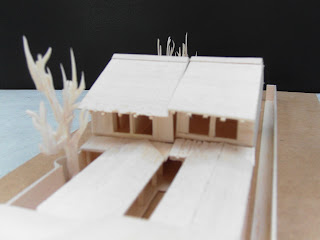






Front Facade, looking down the main axis




Pool in the middle court yard. The design of the building incorporated two innovations: polished coconut trunks were used in conjunction with granite bases and capitals to protect them from termite attack, and the 'tile-on-cement' roof made its first appearance. Bawa had already concluded that the roof was the critical element in tropical architecture and experimented with a number of alternative materials and methods of construction: flat roofs were difficult to seal and tended to get hot, though earth-covered slabs had yielded interesting results; interlocking 'Calicut' or 'Mangalore' tiles were lightweight and required relatively minimal timber support but offered little insulation; traditional flat Kandyan tiles needed high maintenance and had to be laid to steep pitches; corrugated cement sheeting was light, easy to support and highly waterproof but unbearably hot and totally unattractive; the half-round 'Portuguese' tile produced a pleasing texture and good thermal mass, but its double layering required a complex and costly timber structure of battens, close-spaced rafters, purlins and trusses. While seeking a solution for the roof of a house in Jawatte Road, Bawa hit upon the idea of laying Portuguese tiles in and over the corrugations of cement sheeting. This marriage combined the advantages of the two materials - excellent waterproof qualities, good insulation and attractive appearance and minimized their disadvantages. Extra tiles were laid at the ridge and the eaves to prevent slippage and improved adhesion was achieved by adding cement fillets.The new office offered the perfect opportunity to try out the new idea on a substantial building, and its immediate success prompted its adoption for many subsequent projects. Robson, David. 2002. Geoffrey Bawa: The Complete Works. London: Thames and Hudson |